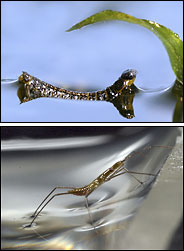Your average water-walking insect makes a mountain out of a meniscus. For a water strider or other bug on the surface of a pond, the spot where water meets the shore, a stick or another object presents an obstacle - an upward-curving meniscus created by surface tension - that is like a mini-Mount Everest.

The beetle larva, top, can scale a meniscus by arching its back, creating meniscuses of its own. Hydrometra does the same with its legs.
Some bugs can, however, scale a meniscus. As revealed by David L. Hu and John W. M. Bush, mathematicians at the Massachusetts Institute of Technology, the bugs do not stride uphill, but rather rely on capillary action to move up the slope in a fixed posture, as if on an escalator.
"They can't run up the meniscus using their traditional means of propulsion," said Dr. Bush, an associate professor who studies fluid mechanics and may be one of the few mathematicians with an insect lab. "So they've developed this peculiar technique."
Using a high-speed camera, Dr. Bush and Mr. Hu, a doctoral student, videotaped the meniscus-climbing behavior of different bugs, including those that tread water, and developed mathematical models of the behavior. (Video, mov format, from mit.edu. More information is at http://www-math.mit.edu/~dhu/Climberweb/climberweb.html.) Their findings are published in the journal Nature.
While the insects are not walking, they are hardly taking it easy. The front and rear legs, which have retractable claws, pull up on the water's surface, creating meniscuses that are drawn by capillary action to the nearby meniscus at the water's edge. "Their muscles are straining to apply the force," Dr. Bush said. The middle legs push down on the water, helping the bug to maintain equilibrium.
The bugs can travel the short distance up the meniscus very fast, up to 30 body lengths, or about 4 inches, per second. (By contrast, the fastest sprinters can run about five body lengths per second.) When they reach the top of the meniscus, the bugs clasp onto the dry surface and pull up the rest of the way.
Even some beetle larvae were able to ride a meniscus, Dr. Bush said, by arching their backs and pulling up on the water at the front and the rear.
He said the movement is based on the same principle that causes Champagne bubbles to migrate to the edge of a glass, or the few remaining corn flakes in a bowl to clump together.
"These bugs live in a world dominated by surface tension," Dr. Bush said. "When things become very small, surface tension becomes important compared with gravity."
Ancient Spider Blood
About 20 million years ago, a spider in what is now the Dominican Republic had a very bad day. It was climbing a tree when it was hit by a flow of resin coming from the opposite direction. The substance tore off some of the spider's legs and quickly engulfed it.
The resin fossilized into amber, preserving the spider, and now a scientist examining the amber has discovered that it contains several drops of blood. It's the first spider blood, or hemolymph, found in amber.
The scientist, David Penney of the University of Manchester in England, was able to determine much about the last moments of the spider, a previously unknown species in the family Filistatidae, a common one in the Caribbean.
The spider lost four of its eight legs, and two of them are preserved nearby. This indicates that the spider did not walk onto a sticky patch, get stuck and become entombed by resin later. Rather, it was hit by a fast-moving stream of resin of relatively low viscosity. The findings were published in the journal Paleontology.
When a spider's leg is detached in this way, some blood seeps out of what remains of the appendage. Dr. Penney observed a drop near each of two legs. He was able to determine they are drops of hemolymph, and not air bubbles (which are common in amber), because they are not spherical, but have tails characteristic of a moving drop of fluid.
Dr. Penney suggested that the drops could be reservoirs of ancient DNA. Extracting the DNA, a theoretical though unlikely possibility, could help scientists better understand spider evolution. But DNA degrades over time, so it couldn't be used to re-create this spider, à la "Jurassic Park."
Gorillas Also Use Tools
Three of the great apes - chimpanzees, orangutans and bonobos - have demonstrated the ability to use tools in the wild. Chimpanzees, for instance, use sticks to fish for termites in mounds.
Gorillas had been the only great apes not known as tool users in the wild, but now they've joined the club. Scientists from the Wildlife Conservation Society and the Max Planck Institute for Evolutionary Anthropology in Germany have observed two gorillas in the Congo Republic using tree branches and other objects to help with tasks.
One of the animals used a dead tree branch to determine the depth of a pool of water she wanted to wade through. The other used the broken-off trunk of a shrub as a support as she was digging herbs, and then used it again as a makeshift bridge to cross a muddy patch of ground. The observations were reported in the open-access journal PLoS Biology (www.plos.org).










